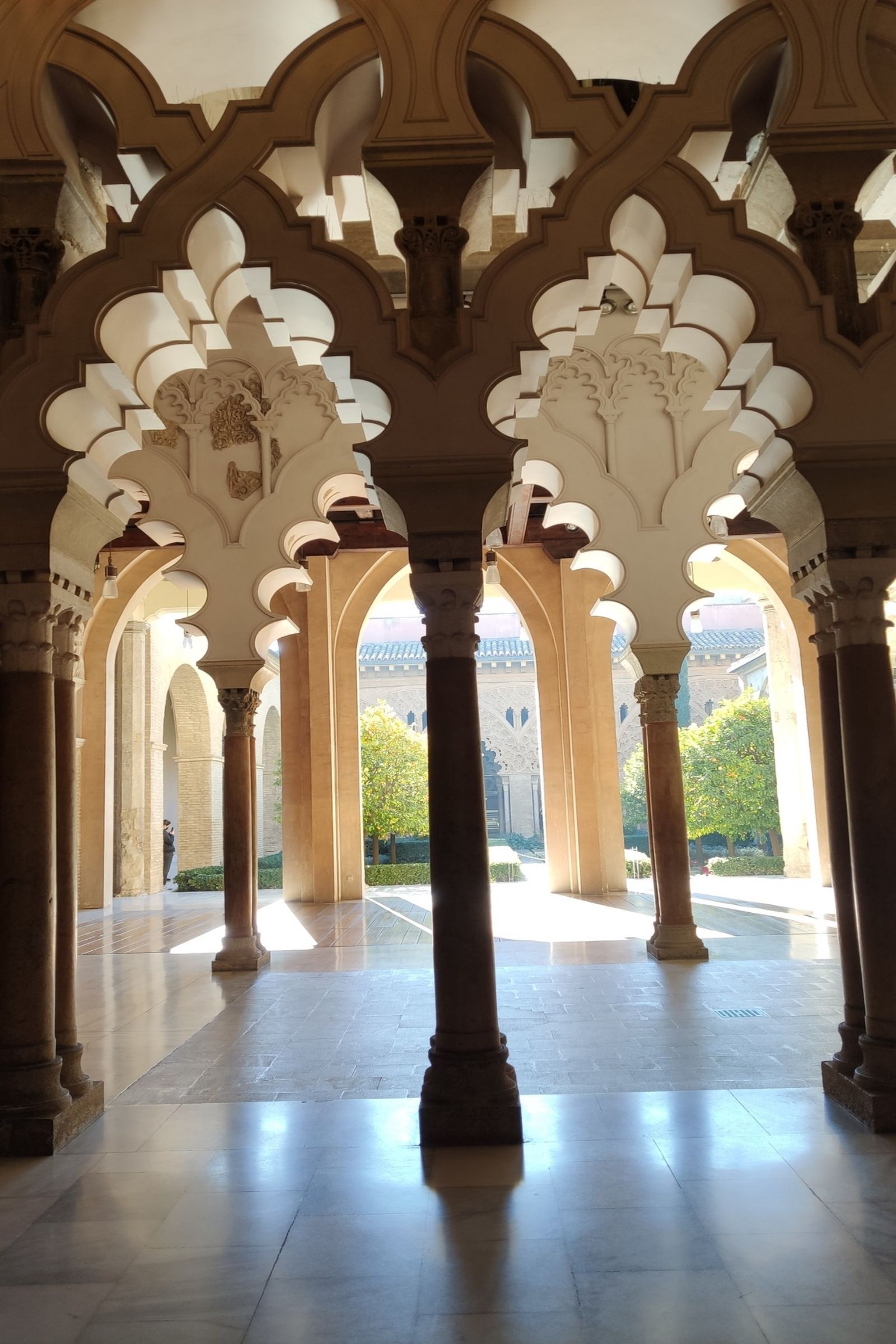La Aljafería Palace
Categories/ tags: Portable building techniques; Utilization of water and wind power.
Historical context: Welcome to the captivating world of La Aljafería, a jewel of Islamic architecture nestled in Zaragoza, Spain. This historic palace, originally designed as a summer retreat for Arabian caliphs during the Iberian Peninsula’s rule, has evolved into the seat of the Aragonese Parliament, the Cortes de Aragón.
Constructed in the latter part of the XI century within the Taifa of Zaragoza in Al-Andalus, present-day Zaragoza, Aragon, Spain, this fortified medieval palace served as the residence for the Banu Hud dynasty during the reign of Abu Jaffar Al-Muqtadir.
La Aljafería’s roots date back to the Arab caliphs who sought respite from the scorching summer heat. Today, it stands as the northernmost Arab palace globally, representing a unique blend of history and architectural prowess.
Form – main architectural features: The palace, a masterpiece of Islamic architecture, boasts intricate details and showcases the unique Mudejar style. Not only is it an architectural marvel, but La Aljafería also serves as the last remaining testament to the Taifal period in the Iberian Peninsula. The wealth of the palace is concentrated in three notable areas:
- Golden Hall: Upon entering, visitors are captivated by subtle geometric patterns, slim multifoil arches with alabaster pillars, and a wooden panelled ceiling adorned with cosmic stars. The combination creates an atmosphere of both dignity and beauty.
- The Mosque and the Chapel: Positioned at the eastern end of the entrance hall, a small private mosque or chapel served the monarch and courtiers. The mihrab features a traditional horseshoe arch and a ring of stones, alternating between smooth stones and plant-based reliefs.
- The Patio of Santa Isabel: This open, gardened courtyard unifies the entire palace. Surrounded by multifoil arches, water cascades into a pool, symbolizing the profound importance of water in Muslim culture. The architectural elements within these spaces exemplify the grandeur and sophistication of Taifal architecture, making La Aljafería a captivating historical gem.
Function: La Aljafería’s design goes beyond aesthetics; it ingeniously addresses climatic challenges. Multiple courtyards and gardens are strategically incorporated to facilitate natural ventilation and shading. Latticework and mashrabiya screens control airflow, reducing reliance on energy-intensive cooling systems. The palace serves as a model of bioclimatic architecture, aligning with the principles of sustainability.
Lessons for sustainability: The architectural elements at La Aljafería combat the suffocating heat through innovative design strategies. Courtyards, gardens, and Islamic architectural techniques are employed to optimize shade and ventilation. The use of ornate latticework and mashrabiya screens allows for controlled airflow, showcasing a commitment to passive cooling and reduced energy consumption.
Cultural heritage and tourism: In 2001, UNESCO recognized the Mudejar art of Aragon as a World Heritage Site, with La Aljafería at its forefront. The palace not only stands as an architectural gem but also invites visitors to explore its lush gardens, ornate arches, and the medieval palace of the Kings of Aragon. It is a sensory journey into the heart of Mudejar art, capturing the essence of a bygone era.
Water as a cooling agent: Water features play a pivotal role in La Aljafería’s sustainable design. A central courtyard with a reflecting pool serves as a thermal buffer, moderating temperatures through evaporative cooling. Channels, fountains, and cascades contribute to the cooling effect while creating a soothing soundscape. The palace’s use of water from the Ebro River for irrigation not only maintains greenery but also enhances the overall ambiance during summers.
Ultimately, La Aljafería Palace goes beyond its historical role, emerging as a shining example of sustainable architectural ingenuity. Its teachings on water conservation, natural cooling methods, and the safeguarding of cultural heritage provide essential wisdom for present-day architectural endeavors.
While exploring the palace’s passages and green spaces, you traverse an odyssey through history, observing the harmonious fusion of bygone eras, eco-friendly practices, and cultural legacy. La Aljafería serves as a dynamic affirmation of the everlasting influence of Islamic architecture, resonating with significance in our contemporary context.
Location: Zaragoza – Spain
La Aljafería Palace – Spain
Sources
Ayuntamento de Zaragoza (n.d.). Aljafería Palace. Retrieved January 14, 2024, from https://www.zaragoza.es/sede/portal/turismo/post/palacio-de-aljaferia?locale=en
Aragón Digital. (2023, August 15). La Aljafería es el palacio árabe situado más al norte del mundo, una joya del arte hispanomusulmán. Retrieved January 7th, 2024, from https://aragondigital.es/sociedad/2023/08/15/la-aljaferia-es-el-palacio-arabe-situado-mas-al-norte-del-mundo-una-joya-del-arte-hispanomusulman/
Arnold, F. (2017). Islamic palace architecture in the Western Mediterranean: A history. Oxford University Press.
Arteguías. (2023, July 1). Palacio Aljafería. Retrieved January 7th, 2024, from https://www.arteguias.com/palacio/palacioaljaferia.htm
Cabañero Subiza, B. (2007). La Aljafería de Zaragoza. Artigrama: Revista del Departamento de Historia del Arte de la Universidad de Zaragoza, (22), 103-130.
Cabañero Subiza, B., & Lupón González, E. (2018). La finca rústica del Palacio Aljafería de Zaragoza en la Edad Media. In Almunias: Las fincas de las élites en el Occidente islámico: poder, solaz y producción (pp. 127-152). Universidad de Granada.
Ewert, C. (1968). Spanisch-islamische Systeme sich Kreuzender Bögen, III. Die Aljafería in Zaragoza. Lingua, 15, 95.
Ewert, C. (1977). Tradiciones omeyas en la arquitectura palatina de la época de los taifas. La Aljafería de Zaragoza. In España entre el Mediterráneo y el Atlántico: actas del XXIII Congreso Internacional de Historia del Arte. Granada, 1973 (pp. 62-75). Comité Español de Historia del Arte.
Ewert, C. (1979). Hallazgos islámicos en Balaguer y la Aljafería de Zaragoza (Vol. 97). Ministerio de Educación.
García-Pulido, L.J., & Pica, V. (2014). Comportamento bioclimatico delle abitazioni vernacolari in ambito mediterraneo. Casi di studio. Ricerche di storia dell’arte, 1/2014, 65-78. https://doi.org/10.7374/77121
Lillo, M. (1982). EWERT, Christian: “Spanish-Islamische Systeme sich kreuzender Bögen. III Die Aljafería in Zaragoza,” Berlín, 1978 (Book Review). Archivo Español de Arte, 55(217), 116.
Sánchez Llorente, M. (2023). Palacio de la Aljafería (parte islámica). Discover Islamic Art, Museum With No Frontiers. Retrieved January 7th, 2024, from https://islamicart.museumwnf.org/database_item.php?id=monument;isl;es;mon01;4;es
Souto, J. A. (1999). EWERT, Gudrun & Christian. “Die Malereien in der Moschee der Aljafería in Zaragoza” (Book Review). Al-Qantara, 20(2), 552-554.


